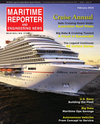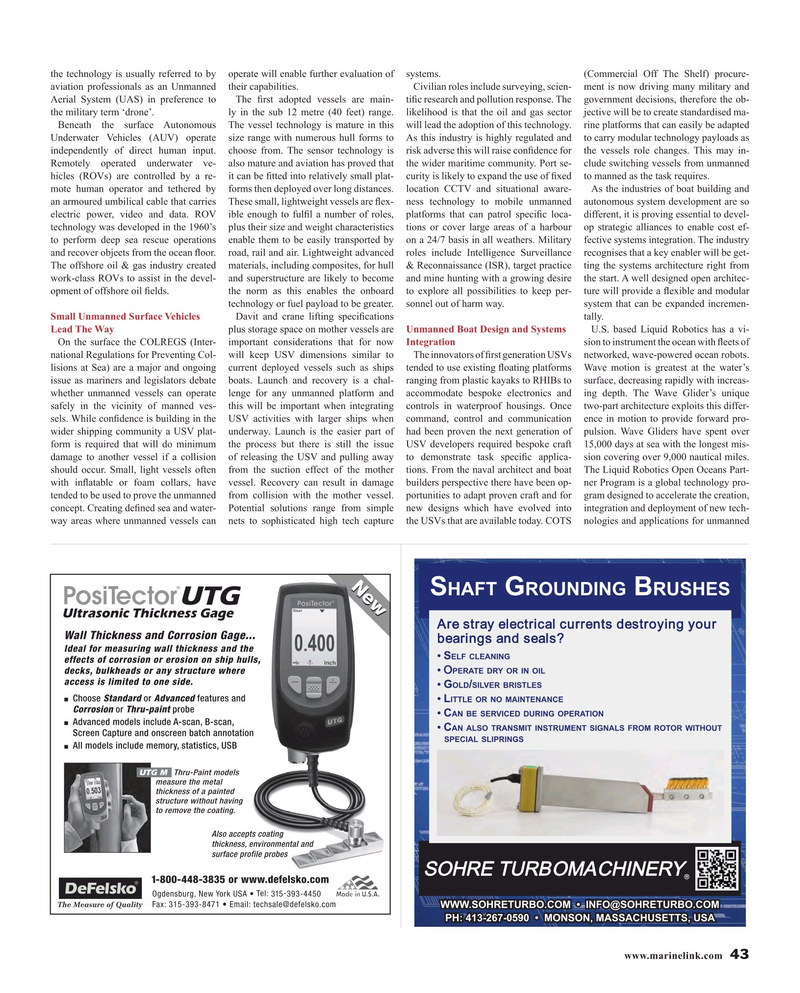
Page 43: of Maritime Reporter Magazine (February 2016)
Cruise Ship Technology Edition
Read this page in Pdf, Flash or Html5 edition of February 2016 Maritime Reporter Magazine
the technology is usually referred to by operate will enable further evaluation of systems. (Commercial Off The Shelf) procure- aviation professionals as an Unmanned their capabilities. Civilian roles include surveying, scien- ment is now driving many military and
Aerial System (UAS) in preference to The ? rst adopted vessels are main- ti? c research and pollution response. The government decisions, therefore the ob- the military term ‘drone’. ly in the sub 12 metre (40 feet) range. likelihood is that the oil and gas sector jective will be to create standardised ma-
Beneath the surface Autonomous The vessel technology is mature in this will lead the adoption of this technology. rine platforms that can easily be adapted
Underwater Vehicles (AUV) operate size range with numerous hull forms to As this industry is highly regulated and to carry modular technology payloads as independently of direct human input. choose from. The sensor technology is risk adverse this will raise con? dence for the vessels role changes. This may in-
Remotely operated underwater ve- also mature and aviation has proved that the wider maritime community. Port se- clude switching vessels from unmanned hicles (ROVs) are controlled by a re- it can be ? tted into relatively small plat- curity is likely to expand the use of ? xed to manned as the task requires.
mote human operator and tethered by forms then deployed over long distances. location CCTV and situational aware- As the industries of boat building and an armoured umbilical cable that carries These small, lightweight vessels are ? ex- ness technology to mobile unmanned autonomous system development are so electric power, video and data. ROV ible enough to ful? l a number of roles, platforms that can patrol speci? c loca- different, it is proving essential to devel- technology was developed in the 1960’s plus their size and weight characteristics tions or cover large areas of a harbour op strategic alliances to enable cost ef- to perform deep sea rescue operations enable them to be easily transported by on a 24/7 basis in all weathers. Military fective systems integration. The industry and recover objects from the ocean ? oor. road, rail and air. Lightweight advanced roles include Intelligence Surveillance recognises that a key enabler will be get-
The offshore oil & gas industry created materials, including composites, for hull & Reconnaissance (ISR), target practice ting the systems architecture right from work-class ROVs to assist in the devel- and superstructure are likely to become and mine hunting with a growing desire the start. A well designed open architec- opment of offshore oil ? elds. the norm as this enables the onboard to explore all possibilities to keep per- ture will provide a ? exible and modular technology or fuel payload to be greater. sonnel out of harm way. system that can be expanded incremen-
Small Unmanned Surface Vehicles Davit and crane lifting speci? cations tally.
Lead The Way plus storage space on mother vessels are Unmanned Boat Design and Systems U.S. based Liquid Robotics has a vi-
On the surface the COLREGS (Inter- important considerations that for now Integration sion to instrument the ocean with ? eets of national Regulations for Preventing Col- will keep USV dimensions similar to The innovators of ? rst generation USVs networked, wave-powered ocean robots. lisions at Sea) are a major and ongoing current deployed vessels such as ships tended to use existing ? oating platforms Wave motion is greatest at the water’s issue as mariners and legislators debate boats. Launch and recovery is a chal- ranging from plastic kayaks to RHIBs to surface, decreasing rapidly with increas- whether unmanned vessels can operate lenge for any unmanned platform and accommodate bespoke electronics and ing depth. The Wave Glider’s unique safely in the vicinity of manned ves- this will be important when integrating controls in waterproof housings. Once two-part architecture exploits this differ- sels. While con? dence is building in the USV activities with larger ships when command, control and communication ence in motion to provide forward pro- wider shipping community a USV plat- underway. Launch is the easier part of had been proven the next generation of pulsion. Wave Gliders have spent over form is required that will do minimum the process but there is still the issue USV developers required bespoke craft 15,000 days at sea with the longest mis- damage to another vessel if a collision of releasing the USV and pulling away to demonstrate task speci? c applica- sion covering over 9,000 nautical miles. should occur. Small, light vessels often from the suction effect of the mother tions. From the naval architect and boat The Liquid Robotics Open Oceans Part- with in? atable or foam collars, have vessel. Recovery can result in damage builders perspective there have been op- ner Program is a global technology pro- tended to be used to prove the unmanned from collision with the mother vessel. portunities to adapt proven craft and for gram designed to accelerate the creation, concept. Creating de? ned sea and water- Potential solutions range from simple new designs which have evolved into integration and deployment of new tech- way areas where unmanned vessels can nets to sophisticated high tech capture the USVs that are available today. COTS nologies and applications for unmanned
NewNew
S G BHAFT ROUNDING RUSHES
UltrasonicThicknessGage
Are stray electrical currents destroying your
Wall Thickness and Corrosion Gage...
bearings and seals?
Ideal for measuring wall thickness and the ?S ELF CLEANING effects of corrosion or erosion on ship hulls, ?O PERATE DRY OR IN OIL decks, bulkheads or any structure where access is limited to one side.
?G / OLD SILVER BRISTLES ¦ Choose Standard or Advanced features and ?L ITTLE OR NO MAINTENANCE Corrosion or Thru-paint probe ?C AN BE SERVICED DURING OPERATION ¦
Advanced models include A-scan, B-scan, ?C AN ALSO TRANSMIT INSTRUMENT SIGNALS FROM ROTOR WITHOUT Screen Capture and onscreen batch annotation
SPECIAL SLIPRINGS
All models include memory, statistics, USB ¦
UTG M
Thru-Paint models measure the metal thickness of a painted structure without having to remove the coating.
Also accepts coating thickness, environmental and surface profile probes
SOHRE TURBOMACHINERY ® 1-800-448-3835 or www.defelsko.comwww defelsko com
Ogdensburg, New York USA • Tel: 315-393-4450
The Measure of Quality
Fax: 315-393-8471 • Email: [email protected] :::62+5(785%2&20?,1)2#62+5(785%2&20 3+?0216210$66$&+86(77686$ www.marinelink.com 43
MR #2 (42-49).indd 43 2/3/2016 11:18:54 AM

 42
42

 44
44
